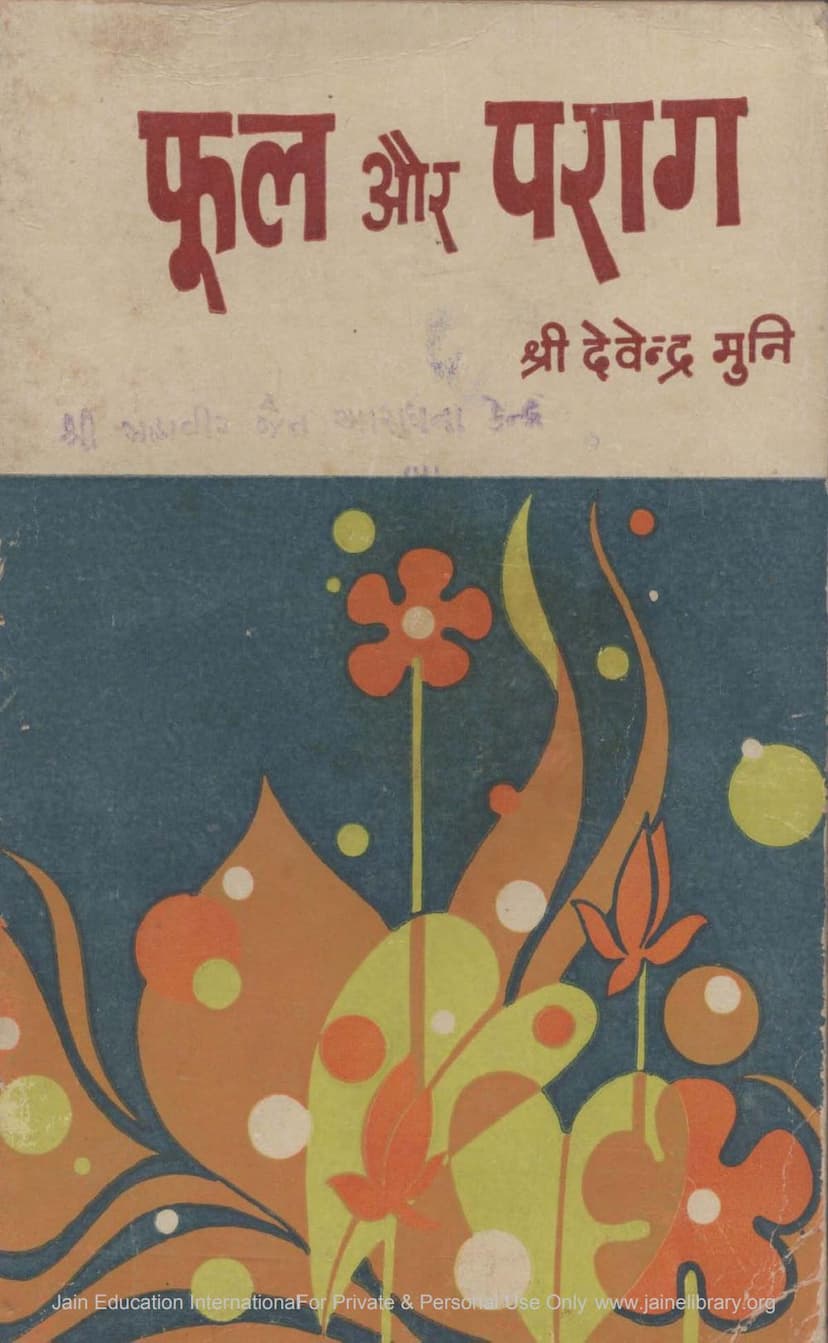Fool Aur Parag
Added to library: September 1, 2025

Summary
Here's a comprehensive summary of the Jain text "Fool aur Parag" by Devendramuni, based on the provided pages:
Book Title: Fool aur Parag (Flower and Pollen) Author: Devendramuni Shastri, Sahityaratna (a disciple of Shri Pushkar Muni Ji Maharaj) Publisher: Shri Tarak Guru Jain Granthalay, Padraada (Udaipur) Publication Date: August 15, 1970 Price: One Rupee Fifty Paise
Overall Theme: "Fool aur Parag" is a collection of 21 stories written by Devendramuni. The underlying purpose of all these stories is to foster the development of pure and virtuous thoughts in humans. The title itself, "Flower and Pollen," suggests that some stories bloom like flowers, while others spread fragrance like pollen, aiming to enrich the reader's inner life. The stories are described as historical, social, and religious, designed to inspire readers to lead pure lives and cultivate pure thoughts.
Key Aspects from the Provided Pages:
-
Introduction and Appreciation: The book is presented as the 7th publication of the Shri Tarak Guru Jain Granthamala. The publisher expresses joy in offering this collection, highlighting the importance of storytelling as a powerful art form that can simplify complex subjects like religion, philosophy, spirituality, and ethics, leaving a lasting impact. Devendramuni is praised as a prominent litterateur of the Sthanakvasi Jain community, known for his research-oriented, thought-provoking, and original works. The publisher also mentions his upcoming book of riddles, "Khilti Kaliyan Muskurate Phool."
-
Author's Perspective (Writer's Foreword): Devendramuni emphasizes the value of storytelling as a "sweet form of literature" that provides both entertainment and knowledge in a simple, enjoyable, and engaging manner. He notes that stories offer "friendly and pleasing advice" which is pleasant to hear and easy to practice. He draws parallels with ancient scriptures like the Vedas, Upanishads, Mahabharata, Agamas, and Tripitaka, all of which extensively use stories to convey teachings. He laments that many modern stories are "sex-dominated" and destructive rather than developmental. He reiterates that his 21 stories in this collection are based on Jain folklore, history, and imagination, all aimed at nurturing noble thoughts. He acknowledges the blessings of his Guru, Shri Pushkar Muni Ji Maharaj, and the contribution of Shrichand Ji Surana 'Saras' in making the book visually appealing and for his editorial assistance.
-
The Stories (Catalog of Tales): The book contains 21 stories with the following titles:
- Aniti ka Dhan (Unjust Wealth)
- Bada Banne ka Mool Mantra (The Core Mantra to Become Great)
- Dhurat ki Amanat (The Cunning Man's Deposit)
- Mrityu ke Pashchat (After Death)
- Pita ki Seekh (Father's Lesson)
- Badi Kaun? (Who is Greater?)
- Mayanall Devi
- Abhimaan Gal Gaya (Pride Melted Away)
- Parasmani (The Philosopher's Stone)
- Haar (Necklace/Defeat)
- Kya Mera Samvat Chalega? (Will My Era Prevail?)
- Khoon ka Asar (The Effect of Blood/Lineage)
- Ghevar (A Type of Indian Sweet)
- Rani ka Nyay (The Queen's Justice)
- Karani Jaisi Bharni (As You Sow, So Shall You Reap)
- Buddhi ka Chamatkar (The Miracle of Intellect)
- Namak se Pyare (Dearer Than Salt)
- Aadmi ki Pehchan (The Identification of a Man)
- Chor Nahin, Devta (Not a Thief, but a God)
- Parivartan (Change)
- Kasai Kevali Bana (The Butcher Becomes a Kevali - enlightened soul)
-
Content Previews (Examples from the stories):
- Aniti ka Dhan: This story likely illustrates how wealth obtained through unjust means is ultimately less valuable and less impactful than even a small amount of wealth earned through righteousness. It contrasts the effect of coins earned righteously versus unrighteously.
- Bada Banne ka Mool Mantra: This story probably explores the true meaning of greatness, contrasting someone focused solely on personal ambition with someone who prioritizes helping others and showing compassion.
- Dhurat ki Amanat: This narrative likely highlights the cleverness and wisdom of a judge or minister in dealing with a deceitful person who falsely claims an item was deposited with an honest merchant.
- Mrityu ke Pashchat: This story seems to be a cautionary tale about attachment to material possessions, perhaps illustrating that even the most beautiful possessions are left behind after death.
- Pita ki Seekh: This story appears to be about a father trying to guide his son away from bad habits and vices through subtle lessons.
- Badi Kaun?: This story likely discusses the relative importance of wealth (Lakshmi) versus knowledge (Saraswati) or possibly other virtues.
- Mayanall Devi: This is likely a historical or legendary tale, possibly about a princess and her choice of a husband or a story emphasizing virtue.
- Abhimaan Gal Gaya: This story probably teaches a lesson about humility, showing how pride can be diminished.
- Parasmani: This story likely uses the metaphor of the philosopher's stone to teach about the inherent potential or value within individuals, often overlooked due to ignorance.
- Khooon ka Asar: This title suggests a story about inherited traits, family influence, or perhaps the consequences of one's bloodline.
- Rani ka Nyay: This indicates a story about a queen dispensing justice, likely demonstrating her wisdom and fairness.
- Karani Jaisi Bharni: This proverb-based title points to a story where the consequences of one's actions are depicted.
- Namak se Pyare: This story likely illustrates the essential nature of something seemingly simple but crucial, perhaps representing how true value is often unrecognized.
- Chor Nahin, Devta: This title suggests a story about a person who appears to be a thief but possesses noble qualities or acts with integrity.
- Kasai Kevali Bana: This is a powerful title suggesting a transformative story where someone engaged in a sinful profession (butchery) achieves spiritual enlightenment.
In essence, "Fool aur Parag" is a collection of moral and spiritual tales intended to guide readers toward a virtuous life, emphasizing the power of good thoughts, ethical conduct, and the enduring value of wisdom and compassion over material wealth or superficial appearances.